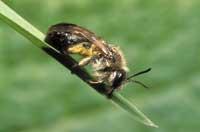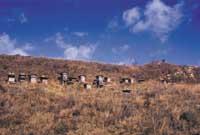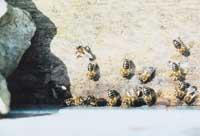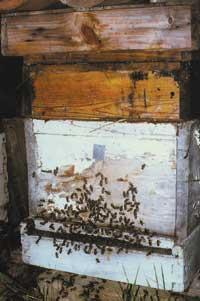A problem of communication between bees

Von Frisch finds it perfectly and later Wolfgan H. Kirchner and William F. Towne has explained in more detail their research that bees communicate to other people the places of interest they have encountered with their ‘tremors’. However, what is in these places is to be indicated in another way: giving to the mouth the nectar or water that they bring from there and making them taste, in the case of liquids, and teaching or flavoring pollen or propolis, in the case of solid contributions. However, the Austrian Nobel Prize left a completely indifferent point that I wanted to play here.
In addition to the direct utilitarian products mentioned above, bees are provided with other more conceptual information, although it is often used spontaneously: what is the most suitable place for the location of the new baby.
The Austrian ethologist studied and explained that, once the son-in-law has left, he hangs on an arboreal path from which exploratory bees leave in search of a new place for the colony. We know that the German Martin Lindauer and, above all, Thomas D. According to the study carried out by the American Seeley, the bees use a series of parameters to measure the suitability of the new location: interior capacity, width of the entrance, height, attitude and orientation and, probably, also the nature of the place (rock, wood...). Thus, once some fertilizer places are found, the explorers return to the group of bees to communicate them, dancing with more intensity and enthusiasm the more favorable the situation of the place, to make others aware of the excellent characteristics of the new residence. In the end, attracted by the enthusiasm of the explorers, more and more bees begin to imitate their ‘dance of vibration’, and taking advantage of the angle so indicated, the whole servant goes to him to found there the new colony.

In this case, when the son-in-law has already left the old hive, separated from it and hung from the apse of a tree, it is evident the urgent need of his bees: to find the place of residence. Therefore, it is clear, simply, what information these explorers want to transmit that do not carry honey, water, pollen or propolis. This is the case that all the researchers have studied so far, that is, how the explorers, once the son-in-law has already left, transfer the information of the new residential areas to the group of bees and spread it in them among other bees. And everyone says that bees also use the same dance they use to warn about other products (honey, pollen, water...).

The reader will forgive me that, in dealing with such a serious issue, a Biscayan woman from the village of Gorozika, who many years ago told me a curious anecdote, I get here, because after all it has to do with this: “One day in the hamlet they lived a marriage with their children. They did not work well for a long time and, to reduce expenses, decided not to drink wine during meals. In addition, they thought that the best measure for this was to prohibit the name of the wine in that house, so they remained in it, that from then on no one in the house could cite the name of the prohibited drink. Say and know. So they remained several weeks, but days later, the table of the house was increasingly sad without sweet breasts. At the end, after a month and a half, at noon, the lady of the house, a worm, once said that the hallub, accompanied by a glass full of water, ate: “Oh, how good it seems to one another” And just hearing it, the man, apparently fond of the bertso, replied with the following text: “That’s going to look for it with the bottle!” And to this, even if the name of the forbidden fruit has not been pronounced, from that meal they had the opportunity to memorize what everyone knew.

Somehow, bees do the same when they make a baby. The main and urgent need for this context, like wine at the table of that hamlet, is to find a new residence among the bees of the son-in-law, so the information provided by the explorers can only be that, like those indirect mentions of marriage, clearly expressed everyone's favorite drink.
However, sometimes explorers advance their work and, a week before the thermometer leaves the hive, they look for a place. In fact, all beekeepers have ever had that experience, seeing some exploratory bees cleaning the empty hives of our hive, precursors of all the time that came a few days later.

This previous formation, logically, radically changes the sense of communication, since it must serve to express in the abstract something that will need a few days later, without a message of immediate and sudden urgency. This forecast that bees show for a thing that has a delayed or delayed use in time, which is very rare in the case of animals, denounces for itself the degree of ‘intelligence’ of these insects or, if they prefer, the complexity of their mental operations.
In any case, leaving aside the field of animal psychology, the question that worries me this time would be how to solve the exploratory bees that have found a new place, among the messages of honey, water, pollen or other explorers that have found the propolis, to inform them that their place is ‘where to live’. Keep in mind that this communication with the rest of the bees is not only done at the last minute, that is, when the first one who has found the chosen place has managed to attract other people so that, together with him, begin to perform the cleaning and conditioning tasks of the place before attracting the rest. But how does that first explorer get to communicate to others what he has discovered?

In the case of pollen, honey, water or propolis, it is apparent that, in addition to the angle and access distance (indicated with the frequency of vibration), the object to be found or searched is clearly indicated, giving it to taste, smell or physically display it. But this cannot be done when we talk about a place, because it does not seem that they bring visible or extravagant samples of that place. This, in addition, in many cases would be impossible, while empty trunks or abandoned hives that had previously occupied other bees may have a certain “smell of wax”, since in other cases the place is completely clean and without the previous signs or smells. On the other hand, so far no one has proven that bees, without any other physical support, can bring with them “empty smells”. And yet, without a doubt, they know how to express that specific message well and separately, without confusing it with other subsequent messages. What does it say to beehive bees, therefore, that what these explorers want to communicate is ‘place’ and not, for example, ‘flower field’?

As in Sherlock Holmes' novels, when all possible culprits have been logically relegated, the suspect who is left without cover or justification, despite being the most atypical to be killed, must necessarily be an exclusive killer. And here we should also act, with empirical experimentation, because, in my opinion, it is impossible to prove it, because the bees that are going to look for a place have to live in overpopulated hives — otherwise they would not look for new places — and in this type of hives it is not possible, in my opinion, to investigate in detail the relationships of the exploratory bees marked with other bees, which are lost among a thousand insects in the colony. Therefore, if I cannot do it, and as a hypothesis, I would like to suggest a logical solution, even if we know that logic and reality do not always coincide.
Surely this solution is due to my professional deformation. Those of office or devotion who study languages use the word morpheme to modify syntactically the meaning of words, to express the smallest elements it contains. In Basque, morphemes are letters, especially suffixes, that is, fractions that are placed next to a word or root. For example, in the present forms of the verb jakin, know - on the basis -t, -k, -n, -gu, -zu, -zue, -you are added, know, know, know, know, know, know, know, know, know, know, to create personal forms. But there is one that is the verbal form of the third person of the singular, which has no mark, since to distinguish between eight things it is enough to mark seven, which has no sign, because it is precisely the very lack of mark that marks. This is known as zero mark (ø) and in practice has the same differential value as other positive brands.

The phenomenon that occurs in bees is, in my opinion, that local information, represented by angle and distance, which point to it through dance, does not carry with it additional stimuli of taste, smell or vision, only means: ‘the place itself’, that is, the ‘pure location’, and the absence of organoleptic additions – in this case marks zero – emphasizes the special topographic character of the message to interpret it as ‘residence’.
I know, to some extent, that this solution will look like someone like one of Fernando de Amezketa's solutions. In short, what is proposed here was something already known: the message of the bees is articulated in two parts: a) the place (represented by the dance) and b) the one that is in that place (collected with the taste smell). This can make us think that when there is no second part, thanks to the first, at least the place is expressed spontaneously and automatically, but do not be deceived by the versatility of the meaning of place.
In fact, bee dance reveals something ‘where’, but it doesn’t explain what’s there. In this case, however, what insects really understand is the ‘place where you are’, the ‘residence’. On the other hand, bear in mind that bees, throughout their lives, transmit almost every day the concepts of ‘nectar’, ‘honey’, ‘water’, ‘pollen’ or ‘propoli’, but they do not have to indicate the concept of ‘residence’ once a year, so it is logical to suspect that this meaning should also be specially coded to avoid misunderstandings in such an important message. Therefore, given that in many everyday messages it is customary to receive the supplement of flavor or smell next to the location always and without exception, in these exceptional and particular cases, it could be said that not pick up that second complement, an unusual signal, an unexpected and eye-catching brand, that it is known that there is a ‘possible accommodation’.

As I said before, I do not think that conducting experiments to check this suspicion can be simple at some point, since the exploratory bees looking for a place do not provide any material contribution to the face, but this solution that I have presented has, at least, an obvious advantage in their favor of the resource economy. In any case, it is possible that someone who at some point had more imagination and means than I can demonstrate this problem. With what we are waiting for the future.





